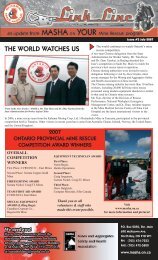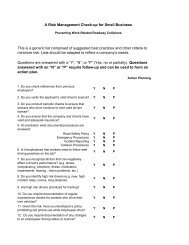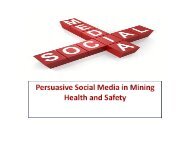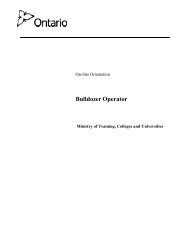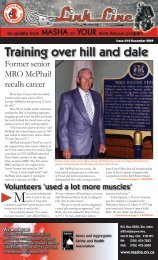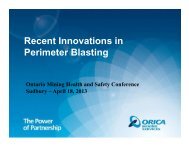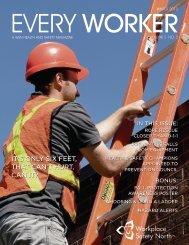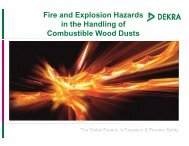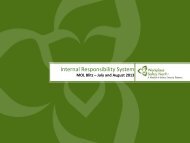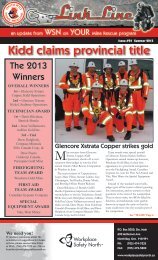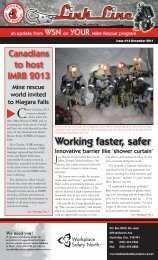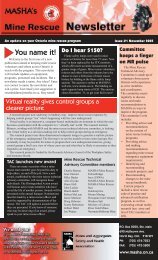a conveyor guard may have saved his life - Workplace Safety North
a conveyor guard may have saved his life - Workplace Safety North
a conveyor guard may have saved his life - Workplace Safety North
You also want an ePaper? Increase the reach of your titles
YUMPU automatically turns print PDFs into web optimized ePapers that Google loves.
champion within each facility involves<br />
maintenance people, supervisors and<br />
operators as well as joint health and safety<br />
committee members in finding solutions to<br />
the <strong>guard</strong>ing-related hazard.<br />
S.A.F.E. Engineer’s Fridlyand agrees that<br />
communicating with all the people who<br />
interact with the machine is very important.<br />
“Some people just put a box (around the<br />
hazard) and it’s absolutely safe, meets all<br />
the standards, no problem, but you cannot<br />
operate t<strong>his</strong> machine or t<strong>his</strong> machine<br />
becomes unproductive. And what happens?<br />
If t<strong>his</strong> is a production machine, and it<br />
hampers production, people remove <strong>guard</strong>s.”<br />
3. At Norampac, the next step is to call in a<br />
pre-qualified engineering firm to review the<br />
situation based on the internal risk analysis,<br />
production process, materials being used,<br />
lockout capabilities, equipment limitations,<br />
and the current mechanical or electrical<br />
<strong>guard</strong>ing systems of the machine.<br />
4. Norampac reviews the initial engineering<br />
report with the engineering firm to make sure<br />
all of the bases are covered. Out of that review,<br />
a final engineering report is created which<br />
is also reviewed by plant staff to make sure<br />
nothing was missed. Equipment efficiency<br />
is also a key component that needs to be<br />
addressed. The way in which plant personnel<br />
interact with the machine will change, so new<br />
safe work procedures must be developed. It is<br />
Marshall Greensides, Health and <strong>Safety</strong> Coordinator<br />
for Norampac, Mississauga<br />
also important to ensure new hazards <strong>have</strong><br />
not been created as a result of the changes.<br />
5. The next step is the secondary engineering<br />
review, t<strong>his</strong> time involving the company that<br />
will be installing the new <strong>guard</strong>ing system.<br />
Once the final design is confirmed with plant<br />
staff, including maintenance and operations,<br />
the new safety system is then installed.<br />
6. After installation, the machine is<br />
commissioned and the critical piece in<br />
the process happens: validation. Both<br />
operators and maintenance personnel are<br />
trained during t<strong>his</strong> step.<br />
“Then there’s a stage where we go live,”<br />
Greensides says. “At that point, typically<br />
the engineer is on site, the key person<br />
from the integration (installation) point<br />
of view is on site, and whoever the key<br />
project person is from the plant is on<br />
site.” The important question is: does<br />
the build match the design? “It’s like a<br />
design build check,” says Greensides,<br />
“and then they also test the functionality<br />
of each of the systems.” And over the next<br />
few weeks, the employees are watching<br />
the machine and reporting anything that<br />
seems off to their supervisor. Any changes<br />
or modifications that need to be made are<br />
done in consultation with the engineer.<br />
7. The last phase in the process is the final<br />
engineering review. T<strong>his</strong> is a report from<br />
the engineer, stating that the machine is<br />
now compliant with current and applicable<br />
standards. A copy of that report is then given<br />
to the joint health and safety committee and<br />
kept in a file in the plant.<br />
Greensides believes t<strong>his</strong> <strong>guard</strong>ing process,<br />
among many other initiatives to improve<br />
the safety and organization of the work<br />
environment, has paid off for Norampac,<br />
and has contributed to the decline<br />
in injuries. “We’ve seen a consistent<br />
reduction in our accident frequency over<br />
the last six years.”<br />
S.A.F.E. Engineering’s Simon Fridlyand<br />
can also attest to the benefits of making the<br />
investment in a <strong>guard</strong>ing program over the<br />
long term.<br />
“What’s absolutely important is to provide<br />
safe operation for all people and also to stay<br />
competitive and productive. And those two<br />
goals are easily achievable if you structure<br />
your process in a certain way. So you spend<br />
your money upgrading your equipment<br />
because you need to be compliant, and<br />
transfer liabilities. But if you do t<strong>his</strong> correctly,<br />
there is a payback and if there is a payback, it<br />
pays for all your efforts and continues paying<br />
on and on and on. The most important thing<br />
is that nobody gets hurt. But also because<br />
it’s a productive production machine, you<br />
manage to stay competitive.”<br />
Norampac and S.A.F.E. Engineering are not connected, and t<strong>his</strong> article does not indicate either firm’s<br />
endorsement of the other.<br />
"We’ve seen a consistent<br />
reduction in our accident<br />
frequency over the last<br />
six years.”<br />
www.workplacesafetynorth.ca<br />
7



